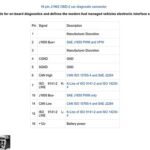The OBDII error code P0420 indicates “Catalyst System Efficiency Below Threshold (Bank 1)”. This means your vehicle’s computer has detected that the catalytic converter isn’t working efficiently. While the catalytic converter itself lacks sensors, the computer relies on oxygen (O2) sensors located before and after the converter to assess its performance. A faulty downstream O2 sensor, often called Bank 1 sensor, is a common culprit for triggering this code because it can send inaccurate readings.
Replacing a catalytic converter is a costly repair, making it crucial to explore other potential causes first. A failing or malfunctioning O2 sensor is a more frequent and less expensive fix, generally costing between $80 and $125 per sensor, plus labor if professional installation is required.
Another potential trigger for the P0420 code is a faulty internal coolant temperature sensor. If this sensor malfunctions, it can mislead the computer into believing the engine coolant is hotter than it actually is. This can cause the engine’s cooling fans to run excessively, keeping the engine cooler than optimal. A cooler engine tends to produce higher emissions, preventing the catalytic converter from reaching its required operating temperature and potentially triggering the P0420 code. Fortunately, coolant temperature sensors are relatively inexpensive to replace. A qualified mechanic can test these sensors using a voltmeter to confirm their functionality before replacement.
Finally, it’s worth noting that original catalytic converters (and pre-cats) often have an extended warranty mandated by federal law, typically covering 8 years or 80,000 miles. If your vehicle falls within this timeframe and mileage limit, the repair might be covered under warranty. However, keep in mind that O2 sensors usually have a shorter warranty period, typically around 4 years or 50,000 miles. Consult your vehicle’s warranty information for specific details.

